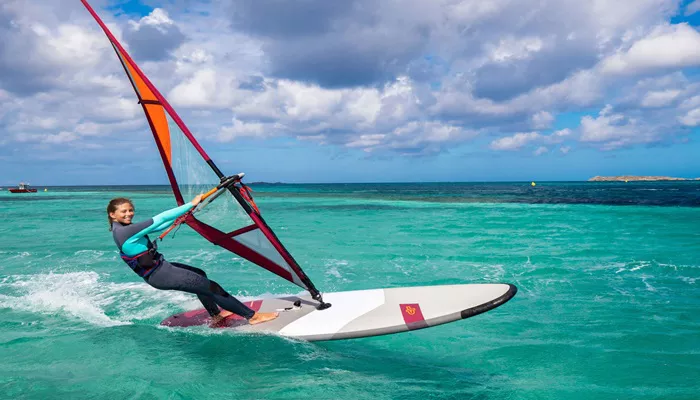Windsurfing is an exhilarating sport that combines elements of sailing and surfing, offering an unmatched sense of freedom on the water. However, before you can hit the waves, you need to properly rig your windsurfing sail. Rigging your sail correctly ensures optimal performance, safety, and durability. This guide will take you through the process step by step, providing detailed instructions to help you rig your windsurf sail efficiently and effectively.
Understanding The Windsurfing Rig Components
Before diving into the rigging process, it’s essential to understand the different components of a windsurfing rig. Each part plays a crucial role in how the sail performs.
Sail: The primary component that catches the wind and provides propulsion.
Mast: A flexible pole that supports the sail.
Mast Base: Connects the mast to the windsurfing board.
Boom: A horizontal bar that allows you to hold and control the sail.
Extension: An adjustable piece inserted into the bottom of the mast to fine-tune sail tension.
Uphaul Rope: A rope attached to the mast that helps lift the sail out of the water.
Downhaul Rope: A rope used to adjust sail tension vertically.
Outhaul Rope: A rope that controls the sail tension along the boom.
Step-by-Step Guide to Rigging a Windsurf Sail
Now that you understand the key components, let’s go through the detailed steps to rig your windsurf sail correctly.
1. Choosing the Right Rigging Area
Select a flat, open area free from sharp objects that could damage your sail. A grassy surface or sandy beach is ideal. Ensure the wind is blowing steadily to help with handling the sail during the rigging process.
2. Laying Out the Equipment
Unroll your sail on the ground with the mast sleeve facing up. Place the mast, boom, extension, and ropes within reach.
Ensure the area is clean to prevent sand or dirt from getting into the mast sleeve.
3. Inserting the Mast into the Sail
Carefully slide the mast into the mast sleeve from the bottom of the sail.
Work the mast through the sleeve until it reaches the top of the sail. Be patient and avoid forcing it, as this can damage the material.
Ensure the mast is fully seated in the sail’s top cap.
4. Attaching the Mast Extension and Mast Base
Insert the mast extension into the bottom of the mast.
Set the extension length according to the sail’s recommended settings (usually found on the sail near the foot area).
Attach the mast base securely to the mast extension and tighten it properly.
5. Applying Downhaul Tension
Thread the downhaul rope through the pulleys at the base of the sail and the mast extension.
Pull the downhaul rope gradually to tighten the sail. The sail should develop a loose leech (the upper edge should have some looseness to spill excess wind and improve control).
Use a downhaul tool or harness to assist with pulling if necessary.
6. Attaching and Adjusting the Boom
Open the front clamp of the boom and attach it around the mast at the recommended height (around shoulder height when standing on the board).
Close and secure the clamp to hold the boom in place.
Adjust the boom length according to the sail’s outhaul settings.
7. Applying Outhaul Tension
Thread the outhaul rope through the clew (the sail’s rear attachment point) and the boom end.
Pull the outhaul rope to tighten the sail along the boom.
Secure the rope in the boom cleat.
8. Fine-Tuning the Rig
Check the downhaul tension: The sail should have a slight curve, with some looseness in the upper panels.
Adjust the outhaul: Too much tension makes the sail flat and hard to control, while too little tension makes it overly powerful and difficult to handle.
Ensure the mast, boom, and ropes are securely fastened.
9. Attaching the Uphaul Rope
Tie the uphaul rope around the mast just above the mast base.
Ensure it hangs loosely but is within easy reach when pulling the sail out of the water.
10. Final Checks and Adjustments
Inspect all connections and ensure nothing is loose.
Look for wrinkles or inconsistencies in the sail tension.
Double-check the boom height and mast extension settings to match your preferences.
Tips for Efficient And Safe Rigging
Check Rigging Guides: Many sails have printed rigging guides with recommended settings.
Use a Rigging Tool: A downhaul tool can make applying tension much easier.
Keep the Sail Clean: Avoid dragging the sail on rough surfaces to prevent damage.
Practice Makes Perfect: Rigging gets easier with experience—practice in a controlled environment before heading into challenging conditions.
De-Rigging And Storing Your Sail
After your windsurfing session, proper de-rigging and storage will prolong the life of your gear.
Loosen the Outhaul and Downhaul: Release the tension gradually to prevent unnecessary stress on the components.
Remove the Boom: Detach the boom and set it aside.
Remove the Mast Extension and Base: Detach these components carefully.
Slide the Mast Out of the Sail: Take your time to avoid damaging the mast sleeve.
Roll the Sail Properly: Roll it from the top down to avoid creases and maintain the sail’s shape.
Store in a Dry Place: Keep your sail and rigging components in a cool, dry place to prevent mold and degradation.
Conclusion
Rigging a windsurf sail is a fundamental skill that every windsurfer must master. By following these detailed steps, you can ensure that your sail is set up correctly for optimal performance and longevity. Proper rigging not only enhances your sailing experience but also keeps you safe on the water. With practice, the process becomes second nature, allowing you to spend less time setting up and more time enjoying the thrill of windsurfing. Whether you’re a beginner or an advanced rider, mastering the art of rigging is a crucial step in your windsurfing journey.

